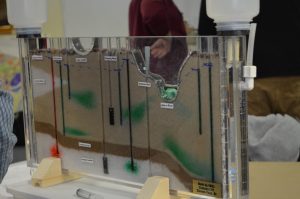 Kevin Masarik, Extension Groundwater Education Specialist
Kevin Masarik, Extension Groundwater Education Specialist
University of Wisconsin-Stevens Point, College of Natural Resources
kmasarik@uwsp.edu
715-346-4276
Total time – 3:08
0:14 – What is groundwater
0:34 – Difference between groundwater and surface water
1:06 – Endless supply of groundwater
2:20 – How to learn about groundwater
2:48 – Sand Tank Groundwater Model link
2:59 – Lead out
TRANSCRIPT
Lorre Kolb: Groundwater: Wisconsin’s buried treasure. We’re visiting today with Kevin Masarik, Groundwater Education Specialist, University of Wisconsin-Madison, Division of Extension and the College of Natural Resources at UW-Stevens Point and I’m Lorre Kolb. Kevin, what is groundwater?
Kevin Masarik: Groundwater is basically rain or snow that infiltrates into the ground and eventually reaches a point where all the empty spaces of the soil; all the cracks in the rock are filled with water and that groundwater is what a lot of us in Wisconsin rely on for our primary water supply.
Lorre Kolb: How is it different than surface water?
Kevin Masarik: Actually surface water and groundwater are really well connected. Anywhere where that water table or that groundwater intersects the land surface is typically where we have a lake, river, stream or wetland. So even though we separate them, we call them surface water and groundwater, they are connected. It’s really groundwater that feeds those surface waters. The differences between the two are the chemistry can be quite different. Surface waters are partially groundwater, but they might also contain runoff over the land surface.
Lorre Kolb: And do we have an endless supply of groundwater?
Kevin Masarik: It’s not endless, it’s hard to imagine running out of groundwater in Wisconsin. Places out west are running out of groundwater. In Wisconsin our groundwater quantity issues are a little bit different. If we talk about what are some of the groundwater quantity challenges in Wisconsin, it’s really talking about pumping large amounts of water out of the ground and what impact does that groundwater pumping have on maybe the lakes, rivers, streams and wetlands. It’s really the upper 5 to 10 feet of the aquifer that is responsible for a lot of our surface water so it’s hard to imagine running out of groundwater in Wisconsin, but certainly lowering the water table by a couple of feet might mean large changes in lake levels or large reductions in stream flows.
Lorre Kolb: And what are some misconceptions about groundwater?
Kevin Masarik: One is it’s an underground lake and we know that’s not true. Other misconceptions is that it’s always clean and pure. And the groundwater, its characteristics are imparted by the soils or the rock that that water moves through. There’s certainly some naturally occurring contaminants that can affect our water as well as anything we do on the land surface will also change the quality of that water sometimes.
Lorre Kolb: How can people learn about what they can’t see?
Kevin Masarik: One of the best tools we have is what we call the Sand Tank Groundwater Model. It’s a small plexiglass container that represents a cross section of the earth’s crust. We can add water to it, we can add dye to it which helps visualize how that groundwater moves through the landscape to maybe a lake, river or stream and can illustrate how things we do at the landscape can impact the quality below.
Lorre Kolb: And if people are interested in learning more about the Sand Tank Groundwater Model?
Kevin Masarik: Google groundwater education UW-Stevens Point.
Lorre Kolb: We’ve been visiting today with Kevin Masarik, Groundwater Education Specialist, University of Wisconsin-Madison, Division of Extension and the College of Natural Resources at UW-Stevens Point and I’m Lorre Kolb.



